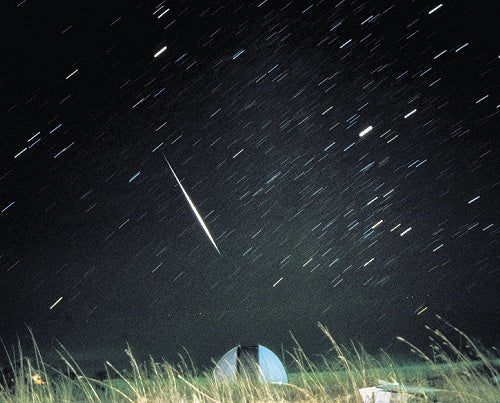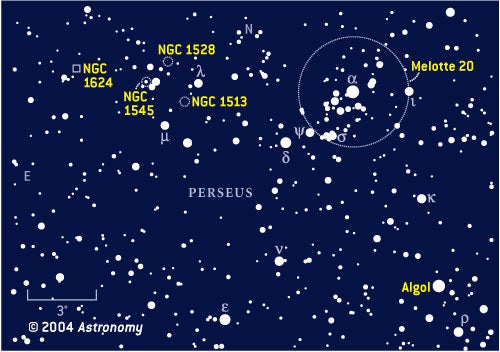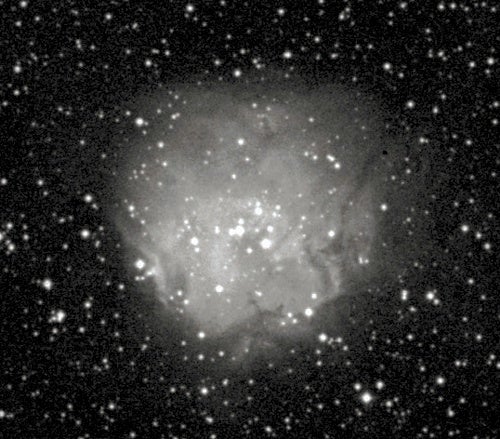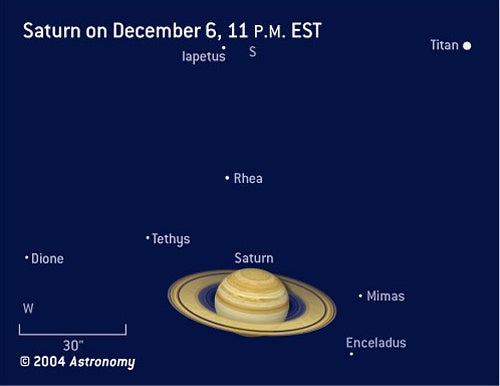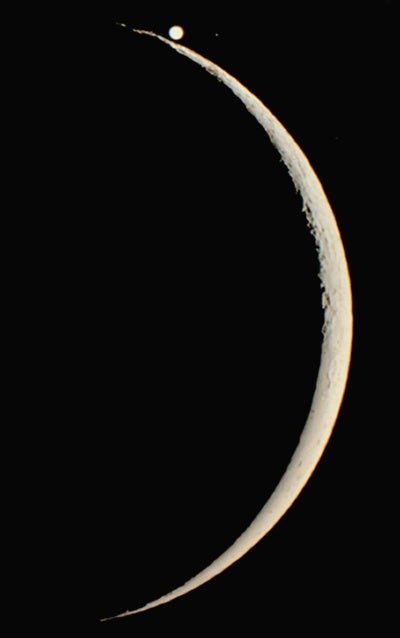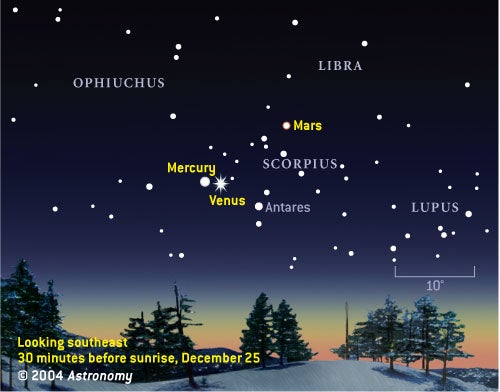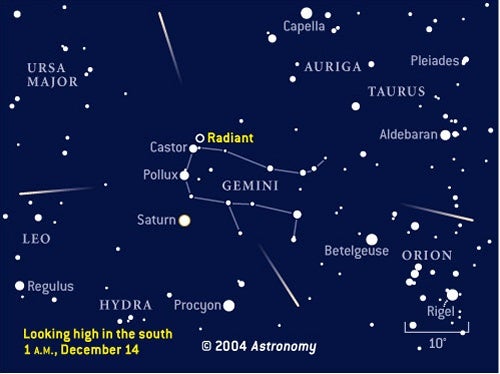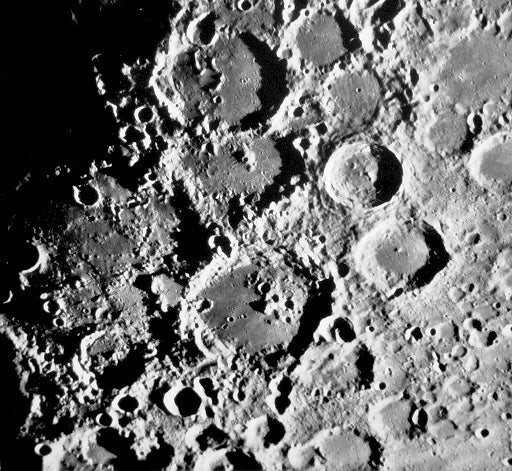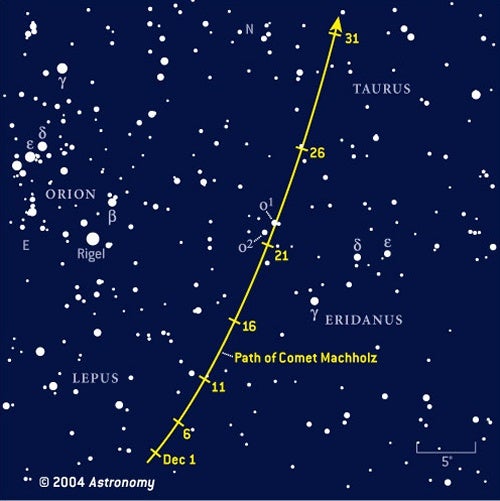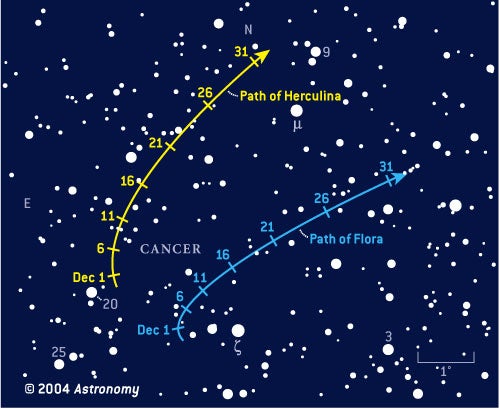Slamming into Earth’s atmosphere at speeds of 22 miles per second (35 km/sec), pieces of rock the size of peas burst into long fiery swords that can rival Jupiter or Venus in brightness. Meteoroids the size of sand grains produce streaks equal to the brighter stars. The majority of Geminid meteors glow around 4th or 5th magnitude, like the brighter stars in the Pleiades, and can be seen only from a location well away from city lights. This year, the Moon cooperates, setting around 6 p.m. on the night of the shower’s peak.
Geminid meteors appear to radiate from the constellation Gemini the Twins. As darkness falls, Gemini is just rising in the northeast. The longest trails streak overhead because we see the meteors broadside instead of almost head-on. As the night progresses, Gemini climbs higher, and the number of observed meteors climbs.
Evening observers can expect a treat this month, as Comet C/2004 Q2 (Machholz) brightens to naked-eye visibility. Glowing at 5th magnitude and sporting a growing tail, this snowball sails north to the right (west) of Orion’s shield. When he first laid eyes on it, comet hunter Don Machholz noted a dim, 11th-magnitude fuzzball. In January, the comet should glow around 4th magnitude close to the Pleiades.
Saturn rises in the east after evening twilight fades. Look for a bright, pale-yellow “star” that doesn’t twinkle. The smallest telescope shows the elongated shape of the rings, but plan to study the planet later in the evening. You’ll see a steadier, more detailed image when Saturn floats high above the worst of the turbulent air close to the horizon.
An equally dazzling sight awaits observers near dawn December 7, when the Moon occults Jupiter. The gas giant’s disk and each Galilean moon gets swallowed by the crescent Moon’s bright limb, then some minutes later, they reappear from behind the unlit portion.
Unfortunately for the western third of North America, the action’s over before the group rises. Console yourself with a lovely conjunction between the Moon and planet. Lunar occultations of planets happen rarely — few observers have seen more than ten in their lifetime. North Americans will have to wait until September 2016 to see the Moon occult Jupiter again.
The morning sky remains a hotbed of planet activity throughout December. Watch as Venus and Mars pair up during the first 10 days of the month. It’s a pity the only time Mars gets this close to Venus is when the Red Planet lies on the far side of the Sun, just an echo of its possible glory. Mars glows 100 times fainter than the morning star.
Innermost Mercury proves easier to see than feeble Mars. As Christmas approaches, look to the lower left of Venus for a yellowish dot. On the 18th, you’ll likely need binoculars to spot Mercury, but by the 22nd, it will be a snap to find with the naked eye.
Watch for the slow dance Mercury makes with Venus. The fleet-footed planet pops into the twilight glow and soon climbs above Venus. Then, during the first week of January, it makes a tight turn and slides below the morning star.
Perseus rescued the fair maiden Andromeda by using Medusa’s head to turn the sea monster Cetus into stone. Bending myth to fit the starry sky, early astronomers chose Algol, the “Demon Star,” to represent Medusa’s head. Algol violated heaven’s supposed perfection with unpredictable drops in brightness, from magnitude 2.1 to 3.4 in a matter of about 3 hours, so it’s no wonder the star was so well known.
Algol’s erratic behavior is only an illusion. In 1782, English astronomer John Goodricke figured out the star changes brightness because it’s an eclipsing binary. With clockwork precision, a fainter star moves in front of, and partially eclipses, its brighter companion every 2.867 days. The puzzled casual observer, if lucky, would see a pair of eclipses separated by three evenings, followed by a 20-night gap until another pair occurred during the evening.
A favorable event for the Americas occurs Saturday night, December 11/12. Algol hits minimum at 12:28 a.m. EST, so start watching around 9 p.m. and take a look every half hour. Use just your eyes to compare Algol’s brightness to that of its neighboring stars. For evening observers, the next minimum comes at 9:17 p.m. EST on the 14th, then comes a jump to January 4.
It seems that open star clusters appeal to the type-B astronomer. With the notable exception of inspiring objects like the Pleiades, most clusters are described as charming, delightful, pleasant, or lovely. To be sure, some don’t stand out well from the background, but all object types have some nondescript members.
Striking is the word that fits the Alpha (α) Persei “moving group.” Also cataloged as Melotte 20, this collection of bright stars splashes across 3° centered on Alpha Persei. The group stands out best in binoculars. A dragon leaps to mind, with yellow Alpha at the nose and orange Sigma (σ) at the tail. Telescopes just don’t do this cluster justice.
Next, slide 7° east of Alpha to Lambda (λ) Per. Through binoculars under a country sky, the cluster NGC 1528 appears as an obvious circular haze just northeast of Lambda. Any telescope shows it is a rich group with a wide range of star brightnesses. You should see a dark lane and arcs of stars jumping out at you. This group punches through city skyglow fairly well.
Only 1.3° southeast of NGC 1528 lies NGC 1545. It may have only 15 to 20 members, but its arms of stars surrounding a pair of yellow luminaries impart a sense of liveliness. Nearby, NGC 1513 is a reclusive, horseshoe-shape group that hides in the Milky Way background at low power. Bump up the power to 90x or so, and you’ll see more stars nicely filling in the gaps.
Star clusters are born in clouds of gas and dust. Most have shed their birth shrouds, but some, like NGC 1624, still are swaddled. You can find this youthful group easily with a Dobsonian or alt-az mount: Simply put the scope on NGC 1545 and come back exactly 20 minutes later, when Earth’s rotation will have brought the cluster into view.
A 4.5-inch scope under a dark sky pulls in the gaseous cocoon with no trouble. With bigger scopes, the cloud shows up better, but its milky glow and diffuse edges leave you contemplating the many different forms of the sky’s nebulae.
Saturn grows to prominence in the east within an hour or so after it rises (it breaks the horizon around 7 p.m. local time in mid-December). Two bright stars stand above Saturn: the luminaries Castor and Pollux in Gemini the Twins. Gleaming at magnitude -0.2, Saturn appears several times brighter than the two nearby stars. On December 1, a waning gibbous Moon rises 45 minutes after Saturn. On the 26th, the Full Moon stands directly above Saturn.
Earthbound observers now can join the orbiting Cassini spacecraft in watching Saturn and its rings. From Earth, telescopes show the rings have closed a little since the planet last appeared in the evening sky. Still, Saturn’s south pole and the southern face of the rings remain on fine view. The planet’s disk currently spans 20″, while the major axis of the rings stretches more than twice that amount, to 46″.
Try spotting Saturn’s still mysterious, gas-shrouded moon, Titan. Practically a planet in its own right — Titan is bigger than Mercury and Pluto — the moon shows up easily through a small scope. The Cassini spacecraft already has flown near Titan once, on October 26, and will do so again this month, on December 13.
Saturn’s second most intriguing moon — at least at this early stage of the Cassini mission — is Iapetus. This moon appears five times brighter when it lies farthest west of Saturn (magnitude 10.1) than when it lies farthest east (magnitude 11.9). During December, Iapetus moves from the west of Saturn to the east, reaching greatest elongation December 27. The best time to spy the moon will be around December 6/7, when it lies due south of the planet.
At the beginning of December, you’ll have to wait until nearly 3 a.m. to see another planet rise. That’s when Jupiter, the solar system’s largest planet, pokes above the eastern horizon. Jupiter lies in Virgo the Maiden all month and stands about 10° northwest of Spica, that constellation’s brightest star. Jupiter shines at magnitude -1.9, far brighter than Spica or any other point of light visible before Venus rises around 5 a.m.
Your first view of Jupiter through a telescope will reveal four bright moons, unless one or more are hidden behind or transiting in front of the planet. Patient viewing will reveal plenty of features on Jupiter’s 34″-diameter disk. Most obvious are two dark equatorial belts that sandwich a brighter zone. Weaker belts and zones and other subtle details appear during moments of good seeing.
For many people, the most interesting event of Jupiter’s entire month comes on the morning of December 7, when the waning crescent Moon passes directly in front of Jupiter and hides it from view. The Moon frequently occults stars, but occultations of bright planets happen quite rarely and appear spectacular. Observers in most of eastern and central North America with clear skies will see this lunar occultation of Jupiter.
Most people in this region will see a total occultation, with the Galilean moons occulted either some minutes earlier or later. The planet itself disappears slowly behind the crescent Moon’s bright limb. Along a narrow track in southern Texas, the Moon will graze Jupiter’s disk, so observers along different parts of this path will see the Moon cover different amounts of Jupiter. See the table for times when Jupiter will disappear and reappear from several representative cities. etails of the graze track and occultation times for other cities can be found on the web at lunar-occultations.com/iota/iotandx.htm.
| Jupiter occultation — December 7 | ||
|---|---|---|
| city | disappearance | reappearance |
| Atlanta | 3:55 a.m. EST | 4:53 a.m. EST |
| Boston | 3:59 a.m. EST | 5:08 a.m. EST |
| Chicago | 2:50 a.m. CST | 3:54 a.m. CST |
| Dallas | 2:56 a.m. CST | 3:37 a.m. CST |
| Houston | 3:06 a.m. CST | 3:29 a.m. CST |
| Kansas City | 2:49 a.m. CST | 3:48 a.m. CST |
| Miami | 4:15 a.m. EST | 4:46 a.m. EST |
| Nashville | 2:52 a.m. CST | 3:52 a.m. CST |
| Pittsburgh | 3:53 a.m. EST | 5:00 a.m. EST |
| Washington, D.C. | 3:54 a.m. EST | 5:03 a.m. EST |
On December 9, the waning crescent Moon stands 8° west of Venus, with Mars 2° closer to the Moon. The following morning, the Moon lies 7° directly below Venus. The Moon’s delicate crescent will be barely visible in the rapidly brightening sky an hour before sunrise. As December moves on, Venus falls farther away from Mars each morning.
By year’s end, Mars lies 7° northwest of its ancient rival, Antares, the brightest star in Scorpius. The Arabic name Antares translates into English as “Rival of Ares,” Ares being the Greek god of war — the same role played by the Roman god Mars. Mars does not yet make a good target for telescope owners because its disk appears a meager 4″ across. However, by late 2005, Mars will return in a fine opposition. This month, it shines at magnitude 1.6, a half magnitude fainter than its stellar rival.
During the third week of December, as Venus continues to sink toward the horizon, Mercury rises up to greet it. The innermost planet reaches greatest western elongation December 29, coincidentally, the same day it passes just 1.2° north of its companion. Mercury then shines at magnitude -0.3.
Venus and Mercury perform an elegant waltz during the last week of December. On the 25th, a telescope reveals Mercury’s half-lit disk lying a scant 2° from Venus. By the first week of 2005, Mercury’s phase will have fattened to 75-percent lit. Venus, on the other hand, appears 92-percent lit. Simple geometry tells us that since the same Sun illuminates both planets, Mercury must be closer to us than Venus, with Venus lying on the far side of the Sun and consequently showing us a nearly full phase.
If the weather cooperates in mid-December, this should be a banner year for the Geminid meteor shower. The action peaks on the night of December 13/14, just 2 days after New Moon, so the biggest source of natural light pollution won’t interfere at all. Dark skies will allow meteor viewers to see the fainter members of this active shower. Geminid activity in recent years has outpaced the more famous Perseid meteor shower in August, although the summer timing of the latter tends to encourage more viewers.
For most observers at mid-northern latitudes, observing the Geminids requires a more adventuresome spirit than what’s needed for a balmy Perseid star party. Be sure to bundle up to keep the cold at bay. Layer on the warmest clothes you have, and bring along a thermos of hot coffee, tea, or chocolate. You may want to head inside every hour or so to warm up, but don’t turn on any lights or you’ll ruin your dark adaption.
At its peak, the Geminid shower generates one, or sometimes two, meteors per minute, on average, with a good percentage of bright meteors. The peak occurs December 13 around 22h UT (5 p.m. EST), so people in Europe and Asia will get the best view. However, the Geminid shower has a broad peak, and observers in the Americas should see an excellent show. The constellation Gemini, from which the meteors appear to radiate, rises in the northeast around 6 p.m. local time and passes nearly overhead shortly after midnight, the best time to observe this shower. One thing is for sure: If you sleep through the Geminids, you won’t see any meteors. So brave the cold — the experience will give you plenty to talk about during the holiday season.
The giant, ancient, walled plain Walter sits in the lunar highlands in the south-central part of the Moon. In fact, it lies directly on the Moon’s central meridian, the line of 0° longitude that bisects the visible hemisphere from north to south pole. Walter sports a massive central peak that casts a long shadow across the crater floor as the Sun rises over the region. (Because Walter lies on the Moon’s central meridian, sunrise occurs at First Quarter phase — on the 18th this month.)
East of the central peak lie three large secondary craters, and many other smaller impact scars dot the surface. Walter’s western wall appears to have a breach, with a flat lava plain lying just to its west where the crater joins with another ancient walled plain, Deslandres. The region surrounding Walter is mountainous. The crater walls themselves rise nearly 13,600 feet (4,130 meters) above the crater floor. If you look carefully, you’ll notice Walter is slightly oval.
It actually is shorter along it’s north-south axis, which spans 82 miles (132 km), than its east-west axis, which measures 87 miles (140 km).
Robotic search telescopes certainly have their strengths. All you have to do is look at the comets we’ve highlighted during the past couple of years to realize that the NEAT and LINEAR search programs now find the majority of comets that come within range of backyard scopes. But human comet hunters continue to make important discoveries.
Late last August, amateur astronomer Don Machholz was patrolling a region of sky closer to the Sun than the search programs usually go. There he discovered a fuzzy patch of light glowing at 11th magnitude. Now, Comet C/2004 Q2 (Machholz) is rapidly approaching both the Sun and Earth. Astronomers predict it will brighten significantly, becoming a nice sight through binoculars and just visible to the naked eye under a dark sky. It should peak during January, reaching 4th magnitude as it passes near the Pleiades star cluster.
Once we hit the second week of December, the glaring light of the Moon will not interfere with evening observations. To locate Comet Machholz, start at the 2nd-magnitude star Delta (δ) Orionis, the westernmost star in Orion’s Belt, make a line through brilliant blue-white Rigel, and then continue in that direction a little farther than the angular distance between Delta and Rigel. After December 16, the Moon’s light will interfere more and more.
Bump up the power to see if there’s any activity near the comet’s core. Often you will see a star-like point, called the false nucleus, because a bright shroud of sunlit dust hides the real nucleus.
An eye looks back
While you’re following Comet Machholz, stop and take a look at the bright planetary nebula NGC 1535. An 8-inch telescope should begin to show its pale green-blue color. With averted vision, our eyes make out faint shapes but are limited to seeing shades of gray. By staring directly at an object, we can detect color and increase our ability to see detail. You’ll get the most out of your telescope if you use both techniques.
Not far from Saturn this month, you can find a pair of bright asteroids. Both 8 Flora and 532 Herculina reside in the main belt of asteroids between the orbits of Mars and Jupiter. Flora measures 86 miles (138 km) across, while Herculina spans 129 miles (207 km).
Flora glows at magnitude 9.1 in mid-December and Herculina at magnitude 9.7. That makes them about the same brightness as the faintest stars shown on the finder chart. The easiest way to identify them is by their telltale motions from one night to the next. Make a sketch of the field, noting the positions of about a dozen stars, then come back a night or two later and see which objects moved.
While you’re in the area, swing your scope to the triple star system Zeta (ζ) Cancri. It’s an easy pair with a third speck tucked tightly against the luminary.

